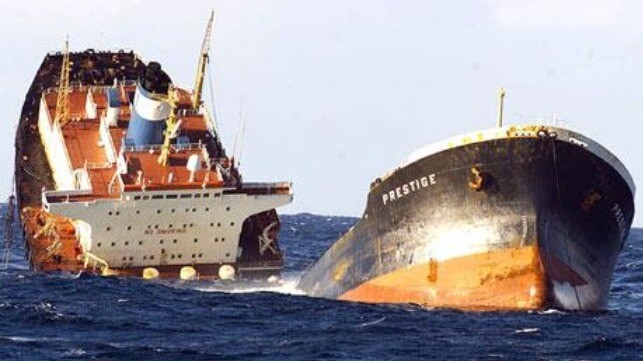Place of Refuge: Lessons from the MT Prestige Disaster

A 'port of refuge' is a maritime safety principle as old as seafaring itself. Without it, a marine casualty can turn into a much larger problem, as illustrated by the notorious case of the tanker Prestige.
On November 13, 2002, the Prestige was navigating the Bay of Biscay carrying 77,000 tonnes of heavy fuel oil. She would soon become the source of Spain's worst ever ecological disaster.
Prestige encountered a powerful winter storm off Spain’s Costa da Morte (the 'Coast of Death'). Captain Apostolos Mangouras reported a loud bang from the starboard side, and the ship began to take on water. Her engines shut down, and Capt Mangouras called for help from the Spanish Coast Guard. The crew were evacuated by helicopter, and the ship drifted within 4 miles of the Spanish coast, already leaking oil.
A Spanish salvage master, Captain Serafin Diaz, was despatched to the ship. Captain Diaz saw a gaping 15 meter hole on the starboard side. He argued that Prestige should be towed into a Spanish port where the leaking oil might be confined, but the Spanish Navy denied her entry. The French government pressured Prestige to change her course and head south into Portuguese waters, in order to avoid endangering France's southern coast.
Fearing for its own shore, the Portuguese Navy intercepted Prestige and prevented her from approaching further. The decision to tow the damaged tanker offshore, rather than escort to a sheltered anchorage was later described as a criminal act and the reason why such a large area was polluted.
The governments of France, Spain and Portugal all refused Prestige entry in her hour of need. After several days under towage, she broke up and sank 160 miles from the Spanish coast. She spilled over 64,000 cubic meters (17 million US gallons) of oil into the sea. The captain of the Prestige was taken into custody, accused of not cooperating with marine salvage crews and of harming the environment
When a ship has suffered an incident, the best way of preventing damage or pollution from its progressive deterioration is to transfer its cargo and bunkers, and then to repair the casualty. Such an operation is best carried out in a place of refuge. However, to bring such a ship into a place of refuge near a coast may endanger the coastal State, both economically and environmentally, and local authorities and populations may strongly object to the operation.
Granting access to a place of refuge is ultimately a political decision, which must be taken on the merits of each case. Consideration must be given to balancing the interests of the affected ship with those of the environment and the local people.
Ships shouldn’t have carte blanche rights of entry to ports when suffering an accident. Unscrupulous shipowners could rely on this option as an excuse for lackluster maintenance, knowing their vessel could seek governmental help at any time. Nonetheless, greater principles of cooperation should be found between nations to assist ships in distress. As the Prestige incident proved, a failure to do so could have devastating environmental consequences for everyone involved.
 Cameron Livingstone MNI is the secretary of the South Eastern Australia Branch of The Nautical Institute, which covers the region of New South Wales and the Australian Capital Territory. The Institute's aim is to promote professionalism, best practice and safety throughout the maritime industry and to represent the interests of its members.
Cameron Livingstone MNI is the secretary of the South Eastern Australia Branch of The Nautical Institute, which covers the region of New South Wales and the Australian Capital Territory. The Institute's aim is to promote professionalism, best practice and safety throughout the maritime industry and to represent the interests of its members.
This article appears courtesy of the author and may be found in its original form here.
The opinions expressed herein are the author's and not necessarily those of The Maritime Executive.
No comments:
Post a Comment